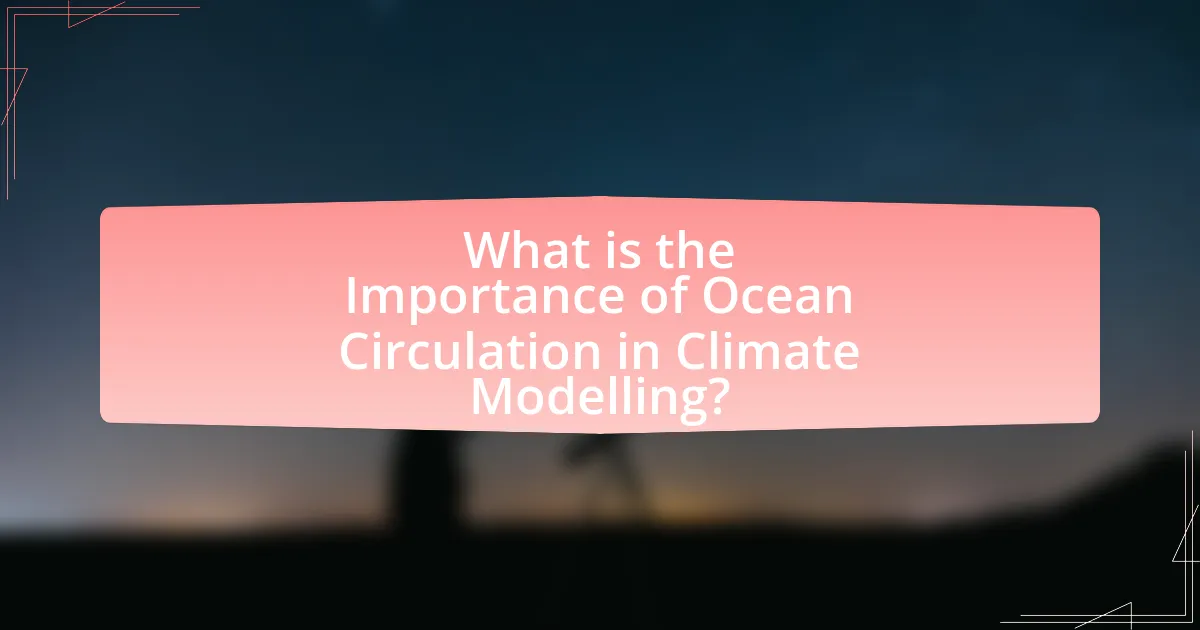Ocean circulation is a critical component in climate modeling, as it regulates global climate patterns by redistributing heat and influencing weather systems. The article explores the significance of ocean currents, such as the Atlantic Meridional Overturning Circulation (AMOC) and the Gulf Stream, in shaping regional climates and precipitation patterns. It discusses the key components of ocean circulation, methods for studying it, and the challenges faced in accurately incorporating these dynamics into climate models. Additionally, the article highlights the impact of ocean circulation on extreme weather events, the carbon cycle, and marine ecosystems, emphasizing its essential role in predicting future climate scenarios and understanding climate feedback mechanisms.

What is the Importance of Ocean Circulation in Climate Modelling?
Ocean circulation is crucial in climate modeling because it regulates global climate patterns by distributing heat and influencing weather systems. The movement of ocean currents affects temperature and precipitation patterns, which are essential for accurate climate predictions. For instance, the Atlantic Meridional Overturning Circulation (AMOC) plays a significant role in transporting warm water from the tropics to the North Atlantic, impacting regional climates and weather events. Studies have shown that disruptions in ocean circulation can lead to significant climate shifts, as evidenced by historical data indicating that changes in AMOC have been linked to abrupt climate changes in the past. Thus, incorporating ocean circulation into climate models enhances their reliability and predictive capabilities.
How does ocean circulation influence global climate patterns?
Ocean circulation significantly influences global climate patterns by redistributing heat and moisture across the planet. The movement of ocean currents, such as the Gulf Stream, transports warm water from the tropics to higher latitudes, affecting regional climates and weather systems. For instance, the Gulf Stream contributes to milder winters in Western Europe compared to North America at similar latitudes. Additionally, ocean circulation plays a crucial role in the carbon cycle, as it helps sequester carbon dioxide in deep waters, thereby impacting atmospheric CO2 levels and climate change. Studies have shown that disruptions in ocean circulation, such as those caused by melting ice caps, can lead to abrupt climate shifts, highlighting its importance in climate modeling and predictions.
What are the key components of ocean circulation?
The key components of ocean circulation include surface currents, thermohaline circulation, and tidal forces. Surface currents, driven primarily by wind patterns and the Earth’s rotation, transport warm water from the equator toward the poles, influencing climate and weather patterns. Thermohaline circulation, also known as the global conveyor belt, is driven by differences in water density, which are affected by temperature and salinity, facilitating the movement of deep ocean waters and playing a crucial role in regulating global climate. Tidal forces, caused by the gravitational pull of the moon and sun, also contribute to ocean circulation by creating periodic movements of water. These components interact to create a complex system that is vital for climate regulation and marine ecosystems.
How do ocean currents affect temperature and weather systems?
Ocean currents significantly influence temperature and weather systems by redistributing heat across the planet. For instance, warm currents, such as the Gulf Stream, transport heat from the equator towards the poles, moderating coastal climates and affecting weather patterns. Conversely, cold currents, like the California Current, can lead to cooler temperatures in adjacent land areas, impacting local weather systems. Research indicates that these currents play a crucial role in the global climate system, as they help regulate atmospheric temperatures and precipitation patterns, which are essential for climate modeling.
Why is understanding ocean circulation critical for climate predictions?
Understanding ocean circulation is critical for climate predictions because it regulates global climate patterns and influences weather systems. Ocean currents distribute heat across the planet, affecting temperature and precipitation patterns. For instance, the Gulf Stream transports warm water from the tropics to the North Atlantic, significantly impacting climate in Europe and North America. Studies show that disruptions in ocean circulation, such as those caused by climate change, can lead to extreme weather events and altered climate conditions, underscoring the necessity of incorporating ocean dynamics into climate models for accurate predictions.
What role does ocean circulation play in climate feedback mechanisms?
Ocean circulation plays a crucial role in climate feedback mechanisms by redistributing heat and influencing atmospheric conditions. This redistribution affects temperature patterns, precipitation, and storm tracks, which are essential for understanding climate variability. For instance, the Atlantic Meridional Overturning Circulation (AMOC) is vital for regulating climate in the North Atlantic region; changes in its strength can lead to significant shifts in weather patterns across Europe and North America. Studies have shown that disruptions in ocean circulation can amplify climate change effects, such as increased frequency of extreme weather events, thereby demonstrating the interconnectedness of ocean dynamics and climate feedback processes.
How does ocean circulation impact extreme weather events?
Ocean circulation significantly impacts extreme weather events by influencing temperature distribution and moisture levels in the atmosphere. For instance, warm ocean currents, such as the Gulf Stream, can lead to increased evaporation, which contributes to more intense storms and hurricanes. Research indicates that changes in ocean circulation patterns, driven by climate change, can alter the frequency and intensity of extreme weather events, as seen in the increased occurrence of hurricanes in the Atlantic since the late 20th century. This correlation underscores the critical role of ocean circulation in shaping weather patterns and highlights its importance in climate modeling.

What are the methods used to study ocean circulation in climate models?
The methods used to study ocean circulation in climate models include numerical simulations, observational data assimilation, and analytical models. Numerical simulations involve using complex mathematical equations to represent ocean dynamics and interactions with the atmosphere, allowing researchers to predict circulation patterns under various climate scenarios. Observational data assimilation integrates real-world measurements from buoys, satellites, and oceanographic surveys into models to enhance accuracy and validate predictions. Analytical models simplify the ocean’s physical processes to derive fundamental relationships and insights about circulation behavior. These methods collectively enable scientists to understand and project the impacts of ocean circulation on climate systems.
How do scientists measure ocean currents and temperatures?
Scientists measure ocean currents and temperatures using a combination of technologies, including satellite altimetry, buoys, and underwater sensors. Satellite altimetry provides data on sea surface height, which helps infer current patterns, while buoys equipped with GPS and temperature sensors collect real-time data on water temperature and current speed at various depths. Additionally, underwater sensors, such as Acoustic Doppler Current Profilers (ADCPs), measure the velocity of water at different depths, providing a comprehensive view of ocean dynamics. These methods are validated by extensive research, including studies published in journals like “Journal of Physical Oceanography,” which demonstrate the accuracy and reliability of these measurement techniques in understanding ocean circulation and its impact on climate.
What technologies are employed in oceanographic research?
Oceanographic research employs various technologies, including autonomous underwater vehicles (AUVs), remotely operated vehicles (ROVs), satellite remote sensing, and buoys equipped with sensors. AUVs and ROVs facilitate the exploration and data collection from deep-sea environments, enabling researchers to gather high-resolution data on ocean currents, temperature, and salinity. Satellite remote sensing provides large-scale observations of ocean surface conditions, such as sea surface temperature and chlorophyll concentration, which are crucial for understanding ocean circulation patterns. Buoys equipped with advanced sensors continuously monitor oceanographic parameters, contributing to real-time data collection essential for climate modeling. These technologies collectively enhance the understanding of ocean dynamics and their impact on climate systems.
How do satellite observations enhance our understanding of ocean circulation?
Satellite observations significantly enhance our understanding of ocean circulation by providing comprehensive, real-time data on sea surface temperatures, currents, and salinity levels. These observations, collected through technologies such as altimetry and remote sensing, allow scientists to monitor large-scale ocean dynamics and identify patterns that influence climate systems. For instance, satellite data has revealed the existence of ocean eddies and gyres, which play critical roles in heat distribution and nutrient transport. Additionally, studies utilizing satellite data, such as those from NASA’s Ocean Surface Topography Mission, have demonstrated correlations between ocean circulation patterns and climate phenomena like El Niño and La Niña, thereby reinforcing the importance of satellite observations in climate modeling.
What are the challenges in incorporating ocean circulation into climate models?
Incorporating ocean circulation into climate models presents significant challenges due to the complexity of ocean dynamics and the scale of interactions involved. Ocean circulation is influenced by various factors, including temperature, salinity, wind patterns, and the Earth’s rotation, making it difficult to accurately represent these processes in models. Additionally, the vastness of the ocean and its three-dimensional nature complicate the modeling of currents and their interactions with the atmosphere and land.
Moreover, the computational resources required to simulate ocean circulation at a high resolution are substantial, often exceeding current capabilities. For instance, high-resolution models that capture fine-scale features of ocean currents require extensive computational power and time, limiting their practicality for long-term climate projections.
Furthermore, uncertainties in observational data, such as gaps in measurements and variability in ocean properties, hinder the calibration and validation of models. These challenges collectively impede the accurate representation of ocean circulation in climate models, which is crucial for predicting climate change impacts effectively.
How do model resolutions affect the representation of ocean processes?
Model resolutions significantly influence the representation of ocean processes by determining the level of detail and accuracy in simulating ocean dynamics. Higher resolution models can capture smaller-scale features such as eddies, currents, and temperature gradients, which are crucial for understanding phenomena like heat distribution and nutrient transport. For instance, a study by Hallberg and Gnanadesikan (2006) in “Ocean Modelling” demonstrated that models with finer resolutions improved the representation of the Antarctic Circumpolar Current, leading to more accurate climate predictions. Conversely, lower resolution models may oversimplify these processes, resulting in less reliable climate forecasts and an incomplete understanding of ocean-atmosphere interactions.
What uncertainties exist in current climate models regarding ocean circulation?
Current climate models exhibit uncertainties regarding ocean circulation primarily due to limitations in representing complex ocean dynamics and interactions with the atmosphere. These models often struggle to accurately simulate processes such as thermohaline circulation, eddy formation, and the influence of freshwater inputs from melting ice, which can significantly alter circulation patterns. For instance, a study published in Nature Climate Change by Kuhlbrodt et al. (2009) highlights that discrepancies in model projections of ocean heat transport can lead to varying predictions of regional climate impacts. Additionally, the resolution of models can affect their ability to capture small-scale features critical for understanding ocean circulation, as noted in the IPCC’s Sixth Assessment Report (2021), which emphasizes the need for improved model resolution to reduce uncertainties.

How does ocean circulation interact with other climate systems?
Ocean circulation interacts with other climate systems by redistributing heat and nutrients across the globe, influencing weather patterns and climate variability. For instance, the Gulf Stream transports warm water from the tropics to the North Atlantic, affecting regional climates and contributing to phenomena such as the North Atlantic Oscillation. Additionally, ocean currents play a crucial role in the carbon cycle by absorbing carbon dioxide from the atmosphere, which impacts global temperatures and climate change. Studies have shown that disruptions in ocean circulation, such as those caused by melting ice caps, can lead to significant shifts in climate systems, demonstrating the interconnectedness of oceanic and atmospheric processes.
What is the relationship between ocean circulation and atmospheric conditions?
Ocean circulation significantly influences atmospheric conditions by redistributing heat and moisture across the globe. This process affects weather patterns, climate variability, and the overall climate system. For instance, warm ocean currents, such as the Gulf Stream, elevate temperatures in adjacent land areas, leading to milder winters in regions like Western Europe. Conversely, cold currents can contribute to cooler temperatures and altered precipitation patterns. Research indicates that changes in ocean circulation, driven by factors like climate change, can lead to shifts in atmospheric circulation patterns, impacting phenomena such as El Niño and La Niña events, which further affect global weather systems.
How does ocean circulation influence the carbon cycle?
Ocean circulation significantly influences the carbon cycle by facilitating the transport and distribution of carbon dioxide (CO2) between the atmosphere and the ocean. This process occurs through mechanisms such as upwelling and downwelling, where surface waters, rich in CO2, are mixed with deeper ocean layers, allowing for the sequestration of carbon in the ocean depths.
For instance, the Atlantic Meridional Overturning Circulation (AMOC) plays a crucial role in this exchange, as it transports warm, CO2-rich water from the tropics to the poles, while bringing cold, nutrient-rich water back to the surface. Studies indicate that oceanic uptake of CO2 accounts for approximately 25% of anthropogenic emissions, highlighting the ocean’s vital role in regulating atmospheric CO2 levels and, consequently, global climate.
What impact does ocean circulation have on marine ecosystems?
Ocean circulation significantly impacts marine ecosystems by regulating temperature, nutrient distribution, and the migration patterns of marine species. The movement of ocean currents influences the availability of nutrients, which are essential for phytoplankton growth, forming the base of the marine food web. For instance, upwelling zones, where deep, nutrient-rich waters rise to the surface, support high biological productivity, benefiting fish populations and other marine life. Additionally, ocean circulation affects the habitats of various species; for example, the Gulf Stream influences the distribution of warm-water species along the eastern coast of North America. Studies have shown that changes in ocean circulation patterns, such as those caused by climate change, can lead to shifts in species distributions and biodiversity, impacting the overall health of marine ecosystems.
What are the implications of changes in ocean circulation for future climate scenarios?
Changes in ocean circulation significantly impact future climate scenarios by altering heat distribution, influencing weather patterns, and affecting marine ecosystems. For instance, the slowdown of the Atlantic Meridional Overturning Circulation (AMOC) could lead to more extreme weather events in Europe and North America, as evidenced by studies indicating that a weakened AMOC correlates with increased winter storms. Additionally, shifts in circulation patterns can disrupt nutrient transport, impacting fisheries and biodiversity, which is critical for food security. Research published in “Nature Climate Change” by Rahmstorf et al. (2015) highlights that changes in ocean currents can lead to sea-level rise along the U.S. East Coast, further illustrating the broad implications of ocean circulation changes on climate systems.
How might climate change alter ocean circulation patterns?
Climate change may alter ocean circulation patterns by increasing ocean temperatures and altering salinity levels, which can disrupt the density-driven currents that regulate global climate. For instance, the melting of polar ice caps introduces freshwater into the oceans, decreasing salinity and affecting the thermohaline circulation, a critical component of global ocean currents. Research indicates that such changes can lead to a slowdown of the Atlantic Meridional Overturning Circulation, which has significant implications for weather patterns and climate stability in various regions, including Europe and North America.
What are the potential consequences for global weather systems?
The potential consequences for global weather systems include increased frequency and intensity of extreme weather events, altered precipitation patterns, and shifts in temperature distributions. These changes are primarily driven by disruptions in ocean circulation, which plays a critical role in regulating climate. For instance, the Intergovernmental Panel on Climate Change (IPCC) reports that a slowdown in the Atlantic Meridional Overturning Circulation could lead to more severe winters in Europe and increased rainfall in the tropics. Additionally, research published in “Nature Climate Change” by Rahmstorf and Coumou (2011) indicates that climate change is linked to more intense storms and heatwaves, further demonstrating the impact of oceanic changes on global weather systems.
What best practices can enhance the accuracy of climate models regarding ocean circulation?
To enhance the accuracy of climate models regarding ocean circulation, implementing high-resolution spatial and temporal data is essential. High-resolution data allows for more precise representation of ocean currents, temperature gradients, and salinity variations, which are critical for understanding ocean dynamics. For instance, the use of satellite altimetry and Argo float data has significantly improved the modeling of ocean circulation patterns by providing real-time observations of sea surface heights and subsurface temperatures. Additionally, incorporating advanced numerical methods and algorithms, such as those used in the Coupled Model Intercomparison Project (CMIP), can refine model simulations by improving the representation of physical processes. These practices collectively contribute to more reliable climate predictions and a better understanding of the role of ocean circulation in global climate systems.


